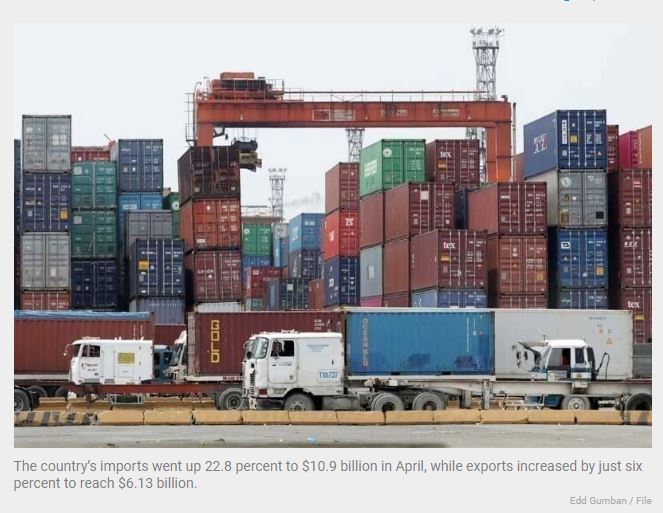Philippines: Trade gap widens to $4.8 billion in April
MANILA, Philippines — The country’s balance of trade in goods expanded in April, as double-digit gains in imports were sustained and outpaced exports, with the Philippines still bearing the brunt of soaring global commodity prices as a consequence of the Russia-Ukraine war.
Data from the Philippine Statistics Authority showed that the country’s trade shortfall surged 54.1 percent to reach $4.77 billion in April from the $3.1 billion in the same period in 2021.
However, the April trade gap was lower than the $5 billion recorded in March of this year.
The country’s imports went up 22.8 percent to $10.9 billion in April, while exports increased by just six percent to reach $6.13 billion.
The expanding trade deficit remained driven by fuel imports whose prices have been on an upward trend since the start of the year and was worsened by the war.
Rizal Commercial Banking Corp. chief economist Michael Ricafort said the trade deficit could hover around the $4 billion to $5 billion level as long as oil and other commodity prices remain elevated.
This could only be offset by reduced demand and disruptions in global supply chains that could be aggravated by new COVID cases in some countries like China.
“Wider trade deficits led to a weaker peso exchange rate versus the US dollar, at 52 levels in recent weeks and months, with more US dollars purchased to finance increased amounts of imports and wider trade deficits,” Ricafort said.
Currently, the country’s fuel import bill is still bloated, which would likely persist especially as the war shows no sign of being resolved. This is expected to contribute to a wider trade deficit in the months ahead.
The country’s total fuel imports in April more than doubled to $2.01 billion from just $862 million a year ago.
Just this week, local pump prices saw another increase. Oil firms raised diesel prices by P6.55 per liter and gasoline by P2.70 per liter.
Consumers have already seen increases of as much as P30 per liter in oil prices since the start of this year.
Meanwhile, overall external trade in goods in April went up 16.2 percent to $17.03 billion from $14.66 billion year-on-year. For the four-month period, cumulative total trade reached $69.77 billion, up 21 percent.
In terms of imports, Ricafort said the economy’s further reopening led to higher imports as well as increased foreign direct investments and infrastructure spending, partly in preparation for the elections.
Apart from fuel, all other top imports of the country increased during the month, except industrial machinery and equipment, and miscellaneous manufactured articles.
Double-digit import gains were recorded in cereals and cereal preparations, transport equipment, iron and steel, and plastics. Other increases were noted in electronic products, other food and live animals, and telecommunications equipment.
For the January to April period, total imports increased 26.7 percent to $44.22 billion.
China was still the country’s biggest supplier of imported goods, cornering 20.8 percent of the total at $2.27 billion.
On the other hand, outbound shipments inched up six percent in April, a three-month low. Exports grew 8.9 percent to $25.55 billion for the four-month period.
Dollar earnings from electronic products, the country’s top export, barely moved at $3.25 billion. Other exports that showed strength during the month include coconut oil, mineral products, cathodes, gold, chemicals and bananas.
Declines were noted in other manufactured goods, ignition wiring sets, and machinery and transport equipment.
The top 10 export destinations of the Philippines increased by 6.5 percent to $5.05 billion. Increases were recorded across all 10 destinations except Japan and Thailand, with the highest gain in Malaysia at 36 percent.
China was the top export destination with $972 million or 15.9 percent of the total exports for the month.
Source: https://www.philstar.com/business/2022/06/10/2187243/trade-gap-widens-48-billion-april


 Thailand
Thailand




